外研版(2019)必修第一册 Unit6At one with nature Using language名师课件(20张ppt)
文档属性
| 名称 | 外研版(2019)必修第一册 Unit6At one with nature Using language名师课件(20张ppt) |  | |
| 格式 | pptx | ||
| 文件大小 | 5.2MB | ||
| 资源类型 | 教案 | ||
| 版本资源 | 外研版(2019) | ||
| 科目 | 英语 | ||
| 更新时间 | 2023-02-26 13:40:18 | ||
图片预览

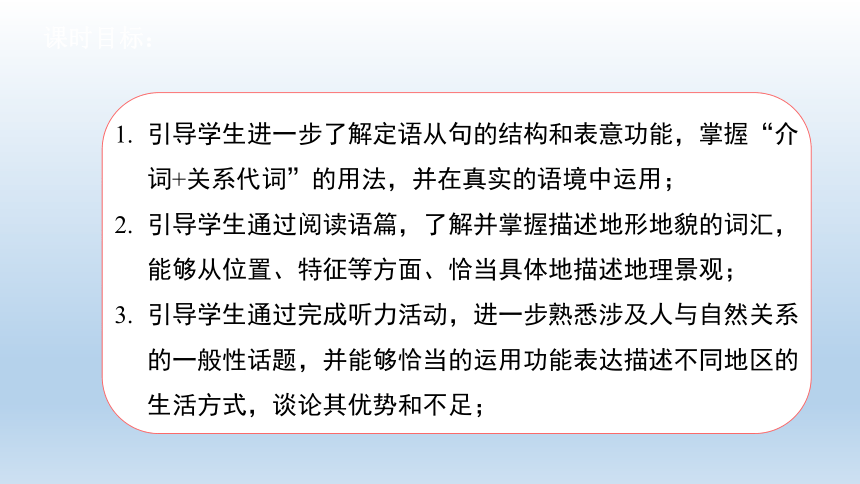
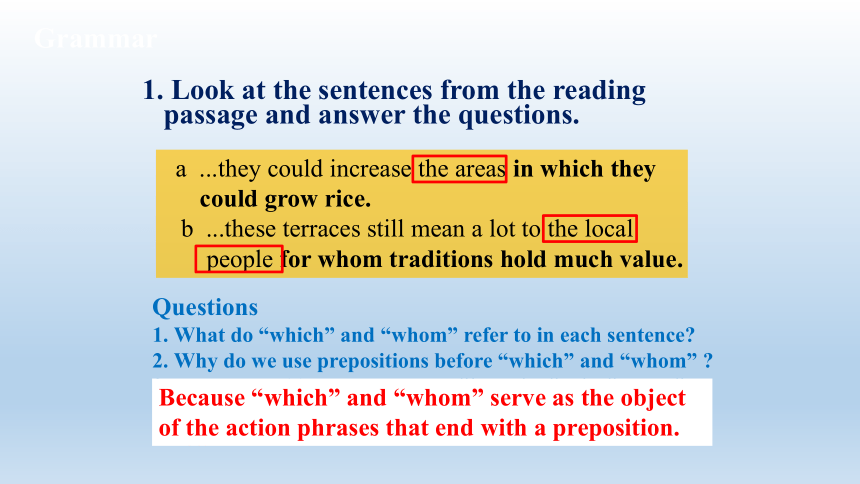
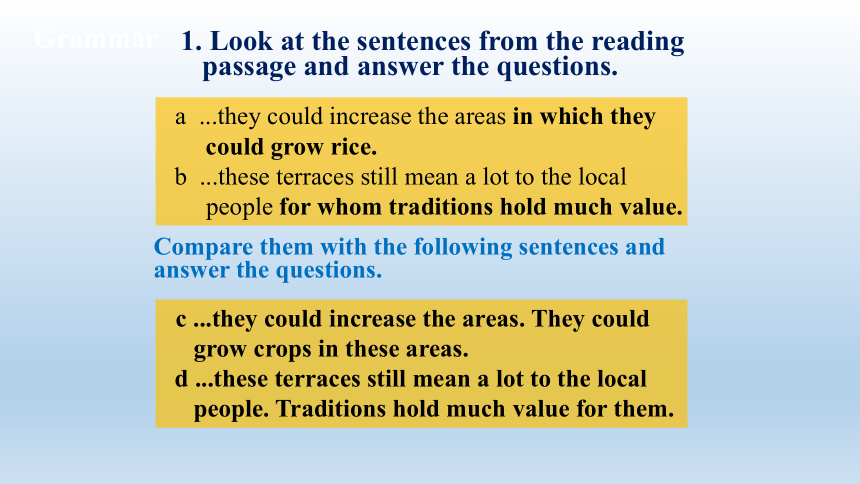
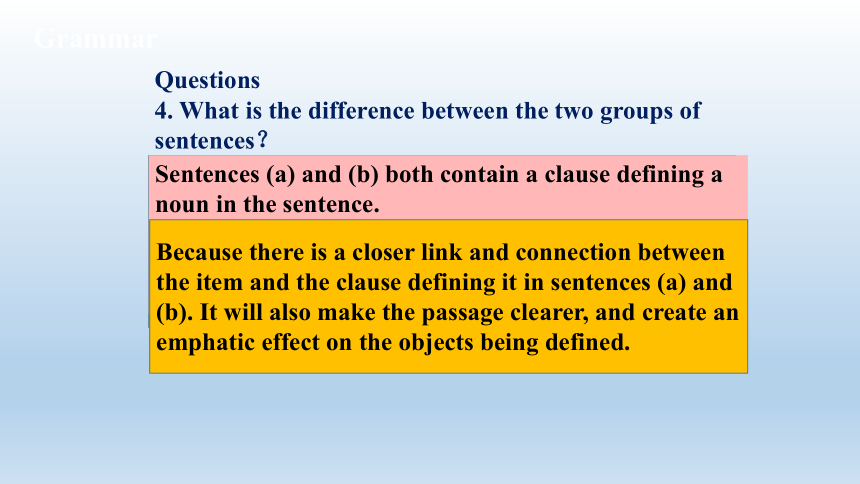
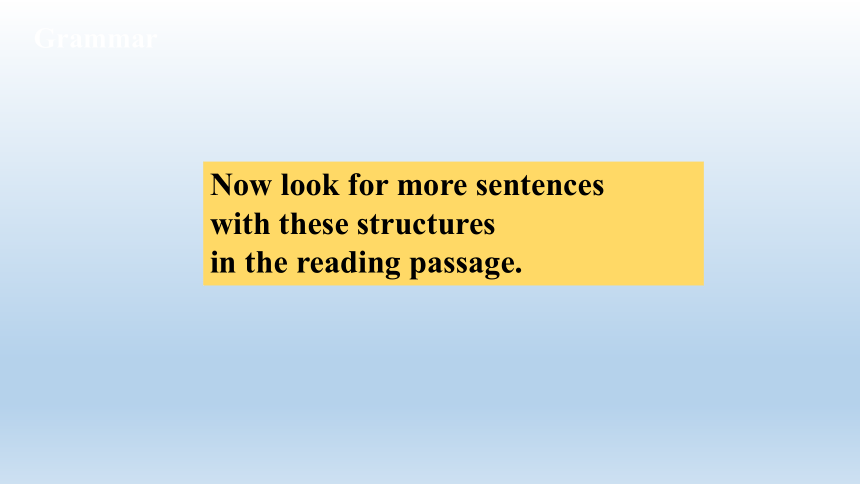
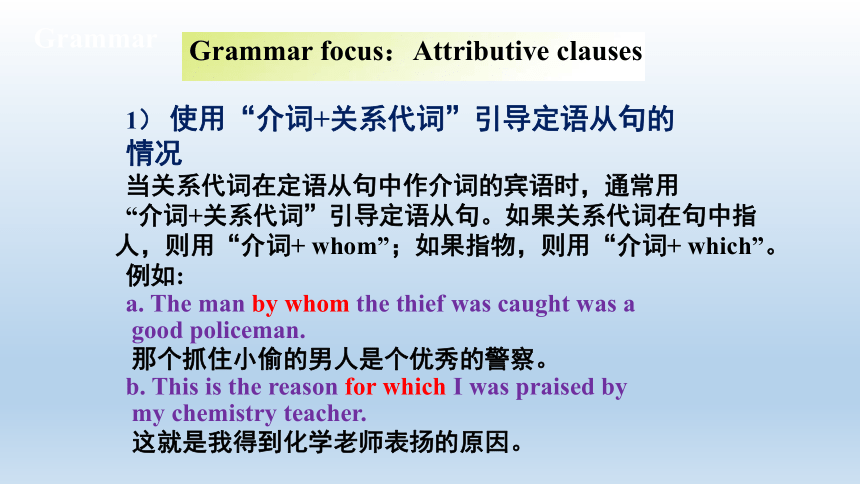
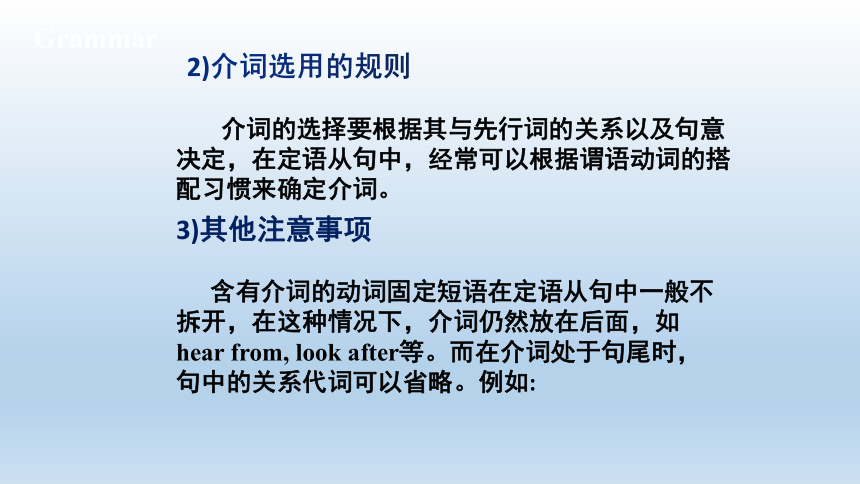
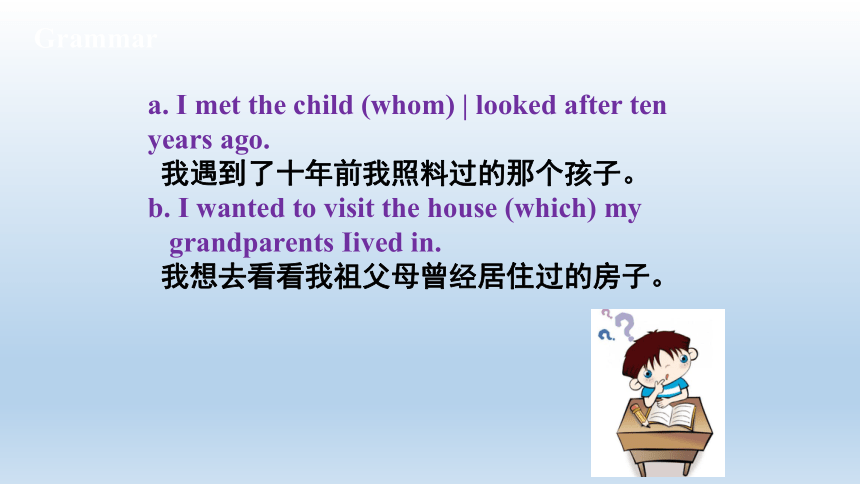
文档简介
(共20张PPT)
Unit 6 Using Language
课时目标:
引导学生进一步了解定语从句的结构和表意功能,掌握“介词+关系代词”的用法,并在真实的语境中运用;
引导学生通过阅读语篇,了解并掌握描述地形地貌的词汇,能够从位置、特征等方面、恰当具体地描述地理景观;
引导学生通过完成听力活动,进一步熟悉涉及人与自然关系的一般性话题,并能够恰当的运用功能表达描述不同地区的生活方式,谈论其优势和不足;
1. Look at the sentences from the reading
passage and answer the questions.
Questions
1. What do “which” and “whom” refer to in each sentence
2. Why do we use prepositions before “which” and “whom”
3 In sentence (a), can we replace "in which" with"where"
without changing the meaning
Yes.
a ...they could increase the areas in which they
could grow rice.
b ...these terraces still mean a lot to the local
people for whom traditions hold much value.
Because “which” and “whom” serve as the object of the action phrases that end with a preposition.
Grammar
a ...they could increase the areas in which they
could grow rice.
b ...these terraces still mean a lot to the local
people for whom traditions hold much value.
Compare them with the following sentences and
answer the questions.
1. Look at the sentences from the reading
passage and answer the questions.
c ...they could increase the areas. They could
grow crops in these areas.
d ...these terraces still mean a lot to the local
people. Traditions hold much value for them.
Grammar
Questions
4. What is the difference between the two groups of
sentences?
5 Why does the author choose to use sentences (a) and (b) in the reading passage
Sentences (a) and (b) both contain a clause defining a
noun in the sentence.
Sentences (c) and (d) are constructed with a pair of
simple sentence, with one defining a noun in the other
sentence in each pair.
Because there is a closer link and connection between the item and the clause defining it in sentences (a) and (b). It will also make the passage clearer, and create an emphatic effect on the objects being defined.
Grammar
Now look for more sentences
with these structures
in the reading passage.
Grammar
Grammar focus:Attributive clauses
1) 使用“介词+关系代词”引导定语从句的
情况
当关系代词在定语从句中作介词的宾语时,通常用
“介词+关系代词”引导定语从句。如果关系代词在句中指人,则用“介词+ whom”;如果指物,则用“介词+ which”。
例如:
a. The man by whom the thief was caught was a
good policeman.
那个抓住小偷的男人是个优秀的警察。
b. This is the reason for which I was praised by
my chemistry teacher.
这就是我得到化学老师表扬的原因。
Grammar
2)介词选用的规则
介词的选择要根据其与先行词的关系以及句意决定,在定语从句中,经常可以根据谓语动词的搭配习惯来确定介词。
3)其他注意事项
含有介词的动词固定短语在定语从句中一般不拆开,在这种情况下,介词仍然放在后面,如hear from, look after等。而在介词处于句尾时,句中的关系代词可以省略。例如:
Grammar
a. I met the child (whom) | looked after ten years ago.
我遇到了十年前我照料过的那个孩子。
b. I wanted to visit the house (which) my
grandparents Iived in.
我想去看看我祖父母曾经居住过的房子。
Grammar
2 Connect the sentences with a preposition + whom
/ which.
1 The Zhuang is an ethnic group. Its population is the
largest of all ethnic groups in China.
2 Guangxi is a province. The Longji Rice Terraces are
located in it.
3 I want to visit this cutural landscape. The title of UNESCO
World Heritage Site was given to it in 2016.
4 He is an expert on rice planting. The local Zhuang people
have learnt a lot from him.
1. The Zhuang is an ethnic group of which the
population is the largest of all ethnic groups in
China.
2. Guangxi is a province in which the Longji Rice
Terraces are located.
3. I want to visit this cutural landscape to which the
title of UNESCO World Heritage Site was given in
2016.
4. He is an expert on rice planting from whom the
local Zhuang people have learnt a lot.
Grammar
3. Complete the passage with a preposition + whom/
which.
Among the many beautiful treasures people can receive from nature are natural dyes. The most common natural source
1 1natural dyes come is plants. Materials for making natural dyes can often be found in gardens 2 i colorful flowers are planted. Other natural dyes are made from insects, sea creatures and mineral compounds.
Natural dyes are now returning to popularity, especially with artists and craftspeople. The reasons 3 they prefer natural dyes are that the colors are brighter and can be kept longer. Natural dyes are also becoming more popular with consumers 4 caring for the environment is a priority. More and more people feel that by using natural dyes, we can remind ourselves of nature's beauty and protect the natural world.
from which
in which
for which
for whom
Grammar
Exercises
Complete the sentences with preposition+ whom or preposition+ which.
Wind power is an ancient source of energy ________we may return in the near future.
Gun control is a subject ________Americans have argued for a long time.
He was educated at a local grammar school, __________ he went on to Cambridge.
There are species living in the depths of the oceans ________ we still know little.
to which
about which
after which
of which
Grammar
5. Today’s English learners have a wide choice of dictionaries __________to choose.
6. A good advertisement often uses words _________ people attach positive meanings.
7. The position, however, ________you are applying, is not quite a well-paid one.
8. In the end, it was Becky _________ he turned for a gentle word and a smile.
9. American women usually identify their best friend as someone they can talk frequently.
10. In our class there are 46 students, ______ half wear glasses.
from which
for which
to whom
to which
with whom
of whom
Grammar
Listening
Look at the following pictures, and try to describe them using your own words, then match them to the pictures.
Suggested answers: 1-a; 2-c; 3-d; 4-b;
Listening
Read the mails, first get the main idea; second, complete the email with the words in bold in activity 4. then read the email loudly, and think about more words to describe the geographical features.
Listening
plain
plateau
Danxia landform
karst
bay
desert
Gobi
coast
glacier
Isthmus
swamp
Words like these:
平原
高原
丹霞地貌
卡斯特
海湾
沙漠
戈壁
海岸
冰川
地峡
沼泽地
Listening
Pre-listening
Read the text “Did you know”, what can you get from it
What other related things do you know
Listening
Listen to a girl talking about Inuit life and identify the things that are mentioned.
Suggested answers:
b d e
Listening
Suggested answers:
1. building materials 2. be kept 3. fight the cold 4. cold weather 5. time 6. boring 7. job opportunities 8. polluted
Homework
With the help of Internet, find the differences between life in southern China and northern china.
Unit 6 Using Language
课时目标:
引导学生进一步了解定语从句的结构和表意功能,掌握“介词+关系代词”的用法,并在真实的语境中运用;
引导学生通过阅读语篇,了解并掌握描述地形地貌的词汇,能够从位置、特征等方面、恰当具体地描述地理景观;
引导学生通过完成听力活动,进一步熟悉涉及人与自然关系的一般性话题,并能够恰当的运用功能表达描述不同地区的生活方式,谈论其优势和不足;
1. Look at the sentences from the reading
passage and answer the questions.
Questions
1. What do “which” and “whom” refer to in each sentence
2. Why do we use prepositions before “which” and “whom”
3 In sentence (a), can we replace "in which" with"where"
without changing the meaning
Yes.
a ...they could increase the areas in which they
could grow rice.
b ...these terraces still mean a lot to the local
people for whom traditions hold much value.
Because “which” and “whom” serve as the object of the action phrases that end with a preposition.
Grammar
a ...they could increase the areas in which they
could grow rice.
b ...these terraces still mean a lot to the local
people for whom traditions hold much value.
Compare them with the following sentences and
answer the questions.
1. Look at the sentences from the reading
passage and answer the questions.
c ...they could increase the areas. They could
grow crops in these areas.
d ...these terraces still mean a lot to the local
people. Traditions hold much value for them.
Grammar
Questions
4. What is the difference between the two groups of
sentences?
5 Why does the author choose to use sentences (a) and (b) in the reading passage
Sentences (a) and (b) both contain a clause defining a
noun in the sentence.
Sentences (c) and (d) are constructed with a pair of
simple sentence, with one defining a noun in the other
sentence in each pair.
Because there is a closer link and connection between the item and the clause defining it in sentences (a) and (b). It will also make the passage clearer, and create an emphatic effect on the objects being defined.
Grammar
Now look for more sentences
with these structures
in the reading passage.
Grammar
Grammar focus:Attributive clauses
1) 使用“介词+关系代词”引导定语从句的
情况
当关系代词在定语从句中作介词的宾语时,通常用
“介词+关系代词”引导定语从句。如果关系代词在句中指人,则用“介词+ whom”;如果指物,则用“介词+ which”。
例如:
a. The man by whom the thief was caught was a
good policeman.
那个抓住小偷的男人是个优秀的警察。
b. This is the reason for which I was praised by
my chemistry teacher.
这就是我得到化学老师表扬的原因。
Grammar
2)介词选用的规则
介词的选择要根据其与先行词的关系以及句意决定,在定语从句中,经常可以根据谓语动词的搭配习惯来确定介词。
3)其他注意事项
含有介词的动词固定短语在定语从句中一般不拆开,在这种情况下,介词仍然放在后面,如hear from, look after等。而在介词处于句尾时,句中的关系代词可以省略。例如:
Grammar
a. I met the child (whom) | looked after ten years ago.
我遇到了十年前我照料过的那个孩子。
b. I wanted to visit the house (which) my
grandparents Iived in.
我想去看看我祖父母曾经居住过的房子。
Grammar
2 Connect the sentences with a preposition + whom
/ which.
1 The Zhuang is an ethnic group. Its population is the
largest of all ethnic groups in China.
2 Guangxi is a province. The Longji Rice Terraces are
located in it.
3 I want to visit this cutural landscape. The title of UNESCO
World Heritage Site was given to it in 2016.
4 He is an expert on rice planting. The local Zhuang people
have learnt a lot from him.
1. The Zhuang is an ethnic group of which the
population is the largest of all ethnic groups in
China.
2. Guangxi is a province in which the Longji Rice
Terraces are located.
3. I want to visit this cutural landscape to which the
title of UNESCO World Heritage Site was given in
2016.
4. He is an expert on rice planting from whom the
local Zhuang people have learnt a lot.
Grammar
3. Complete the passage with a preposition + whom/
which.
Among the many beautiful treasures people can receive from nature are natural dyes. The most common natural source
1 1natural dyes come is plants. Materials for making natural dyes can often be found in gardens 2 i colorful flowers are planted. Other natural dyes are made from insects, sea creatures and mineral compounds.
Natural dyes are now returning to popularity, especially with artists and craftspeople. The reasons 3 they prefer natural dyes are that the colors are brighter and can be kept longer. Natural dyes are also becoming more popular with consumers 4 caring for the environment is a priority. More and more people feel that by using natural dyes, we can remind ourselves of nature's beauty and protect the natural world.
from which
in which
for which
for whom
Grammar
Exercises
Complete the sentences with preposition+ whom or preposition+ which.
Wind power is an ancient source of energy ________we may return in the near future.
Gun control is a subject ________Americans have argued for a long time.
He was educated at a local grammar school, __________ he went on to Cambridge.
There are species living in the depths of the oceans ________ we still know little.
to which
about which
after which
of which
Grammar
5. Today’s English learners have a wide choice of dictionaries __________to choose.
6. A good advertisement often uses words _________ people attach positive meanings.
7. The position, however, ________you are applying, is not quite a well-paid one.
8. In the end, it was Becky _________ he turned for a gentle word and a smile.
9. American women usually identify their best friend as someone they can talk frequently.
10. In our class there are 46 students, ______ half wear glasses.
from which
for which
to whom
to which
with whom
of whom
Grammar
Listening
Look at the following pictures, and try to describe them using your own words, then match them to the pictures.
Suggested answers: 1-a; 2-c; 3-d; 4-b;
Listening
Read the mails, first get the main idea; second, complete the email with the words in bold in activity 4. then read the email loudly, and think about more words to describe the geographical features.
Listening
plain
plateau
Danxia landform
karst
bay
desert
Gobi
coast
glacier
Isthmus
swamp
Words like these:
平原
高原
丹霞地貌
卡斯特
海湾
沙漠
戈壁
海岸
冰川
地峡
沼泽地
Listening
Pre-listening
Read the text “Did you know”, what can you get from it
What other related things do you know
Listening
Listen to a girl talking about Inuit life and identify the things that are mentioned.
Suggested answers:
b d e
Listening
Suggested answers:
1. building materials 2. be kept 3. fight the cold 4. cold weather 5. time 6. boring 7. job opportunities 8. polluted
Homework
With the help of Internet, find the differences between life in southern China and northern china.
